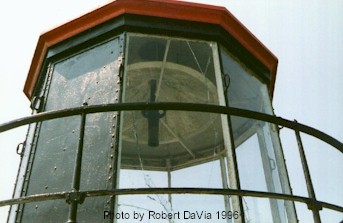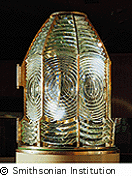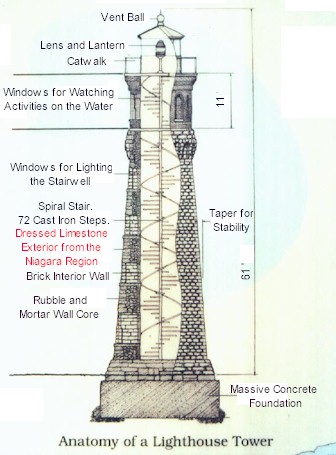Anatomy of a Lighthouse
Certainly the most important aspect of the lighthouse to the mariner is the
light that emanates from the tower. Many people have remarked "oh what a
beautiful light!" (when they meant tower or lighthouse), sometimes people
say that such and such a station has a beautiful light made in France (when they
are really talking about the lens). As long as we are going to discuss
lighthouses, lets use the correct terms.
The lantern room is that portion of the top of a lighthouse tower that
encloses the lens. Often the lantern room or lantern (in the old days it was
called LANTHORN) is a metal and glass room that surmounts a brick, masonry, or
wooden tower. Usually it was constructed by a manufacturer and transported , in
sections, to the site of the lighthouse where it was assembled on the top of the
finished tower.
The lantern is comprised of three parts. The lower SERVICE ROOM -
location of the clockworks (for rotating optics), fuel tanks , and vents. It was
in the SERVICE ROOM that the keeper cleaned the lamp chimneys and prepared the
lantern for the coming night.

Optic Section (minus the optic) from the Thirty Mile Point Lighthouse in
New York
Visible are the Storm Panes, the Astragals, and the Handholds
The next part of the lantern might be called the OPTIC SECTION –
this is the area surrounded by glass windows called storm panes. The storm panes
are set in metal frames. The vertical members are called astragals. Sometimes,
more often in British lighthouses, the astragals were diagonal. Hand holds were
installed on the exterior side of the astragals for the keeper to grip while
standing on a ladder, cleaning the exterior sides of the storm panes. The
interior portion of the horizontal part of the frame were concave to catch any
condensation that formed on the interior face of the lantern panes. The OPTIC
SECTION also contained the heart of the lighthouse, the optic or lens. For many,
many years the "optic" section was open to the elements (no glass
storm panes) and was the area where an open fire burned.

A Fresnel Lens
At the end of the 17th century the lantern was enclosed with
glass and candelabras installed as the "optic". Then, in the 18th
century, banks of parabolic reflectors with lamps fitted with hollow wicks were
the primary source of light. Finally, in 1820 the Fresnel lens was
invented which was powered by a single source of light … the LAMP. Lamps
were of many designs, and at first sperm whale oil fueled the multi-hollow
wicks. However, when the price of this fuel skyrocketed in the 1850’s
European countries turned to Colza Oil (wild cabbage). The United States changed
over to lard and then (in the 1870’s) kerosene. Eventually the oil lamp was
replaced by the electric lamp, generally a 500 or 1,000 watt lamp (bulb).
The final section of the lantern is the DOME. The dome is made of metal and
usually copper clad. It is surmounted by a ball vent through which air can pass.
The ball vent is topped by a lightening rod and sometimes a wind vane to assist
the keeper in discerning wind direction which will help him position the vents
[explained later]. In the interior of the dome, beneath the top, is a
large concave dish surrounding the event tube. This "dish"
catches condensation that forms in the top of the lantern.
The optic consists of the pedestal clockworks and lens which is made up of
dioptric, catadioptric and bullseye prisms.
The keeper was instructed to wear a linen smock so that the
"rough" wool of his uniform wouldn’t scratch the optic or lens. He
was required to clean the interior and exterior of the lantern panes, clean the
optic with spirits of wine (vinegar) and once a year polish the lens with rouge.
The keeper also cleaned the chimney of the lamp, always making sure that spare
clean lamps and chimneys were on hand (usually two). The clock weight was wound
and the clockworks cleaned and oiled (if needed). All preparations for the
coming evening were to be completed by 10:00 am.
In the evening the keeper would ascend to the lantern room and check the
wind direction. Then he would adjust the vents to allow just enough draft into
the lantern room. The entering draft would rise along the interior sides of the
lantern panes (keeping them from "fogging") to the top of the lantern.
The wind passing horizontally through the ball vent would create a vacuum
which pulled the draft up to the top of the lantern room . It also created a
draft in the vent tube which sucked the fumes from the oil burning lamp up the
vent tube to the ball and out of the lantern room. The vent tube was metal and
directly attached to the glass chimney of the lamp.
During the course of the evening, the keeper on watch was required to wind
the weights at least once and trim the wicks of the lamp as necessary. He was
also required to adjust the vents so that a proper draft was present at all
times. Often the lamp chimney needed cleaning.
The balcony’s surrounding the lantern room are called galleries. The
interior of American lantern rooms were painted white although sometimes the
lower Service room portion were finished in natural or stained wood. Exterior of
lanterns were usually red or black although some green and white lanterns did
exist.



